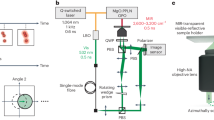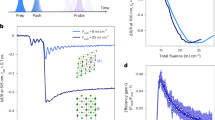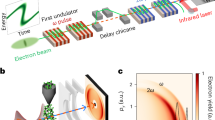Abstract
X-ray free-electron lasers1,2 delivering up to 1 × 1013 coherent photons in femtosecond pulses are bringing about a revolution in X-ray science3,4,5. However, some plasma-based soft X-ray lasers6 are attractive because they spontaneously emit an even higher number of photons (1 × 1015), but these are emitted in incoherent and long (hundreds of picoseconds) pulses7 as a consequence of the amplification of stochastic incoherent self-emission. Previous experimental attempts to seed such amplifiers with coherent femtosecond soft X-rays resulted in as yet unexplained weak amplification of the seed and strong amplification of incoherent spontaneous emission8. Using a time-dependent Maxwell–Bloch model describing the amplification of both coherent and incoherent soft X-rays in plasma, we explain the observed inefficiency and propose a new amplification scheme based on the seeding of stretched high harmonics using a transposition of chirped pulse amplification to soft X-rays. This scheme is able to deliver 5 × 1014 fully coherent soft X-ray photons in 200 fs pulses and with a peak power of 20 GW.
This is a preview of subscription content, access via your institution
Access options
Subscribe to this journal
Receive 12 print issues and online access
$209.00 per year
only $17.42 per issue
Buy this article
- Purchase on Springer Link
- Instant access to full article PDF
Prices may be subject to local taxes which are calculated during checkout



Similar content being viewed by others
References
Emma, P. et al. First lasing and operation of an ångstrom-wavelength free-electron laser. Nature Photon. 4, 641–647 (2010).
Ackerman, W. et al. Operation of a free-electron laser from the extreme ultraviolet to the water window. Nature Photon. 1, 336–342 (2007).
Chapman, H. N. et al. Femtosecond diffractive imaging with a soft-X-ray free-electron laser. Nature Phys. 2, 839–843 (2006).
Nagler, B. et al. Turning solid aluminium transparent by intense soft X-ray photoionization. Nature Phys. 9, 693–696 (2009).
Young, L. et al. Femtosecond electronic response of atoms to ultra-intense X-rays Nature 466, 56–61 (2010).
Tallents, G. J. The physics of soft X-ray lasers pumped by electron collisions in laser plasmas. J. Phys. D 35, R259–R276 (2003).
Rus, B. et al. Multimillijoule, highly coherent X-ray laser at 21 nm operating in deep saturation through double-pass amplification. Phys. Rev. A 66, 063806 (2002).
Ditmire, T. et al. Amplification of XUV harmonic radiation in a gallium amplifier. Phys. Rev. A 51, R4337–R4340 (1995).
Zeitoun, P. et al. A high-intensity highly coherent soft X-ray femtosecond laser seeded by a high harmonic beam. Nature 431, 426–429 (2004).
Wang, Y. et al. Phase-coherent, injection-seeded, table-top soft-X-ray lasers at 18.9 nm and 13.9 nm. Nature Photon. 2, 94–98 (2008).
Whittaker, D. et al. Producing ultrashort, ultraintense plasma-based soft-X-ray laser pulses by high-harmonic seeding. Phys. Rev. A 81, 043836 (2010).
Oliva, E. et al. Optimization of soft X-ray amplifier by tailoring plasma hydrodynamics. Opt. Lett. 34, 2640–2642 (2009).
Oliva, E. et al. Comparison of natural and forced amplification regimes in plasma-based soft-X-ray lasers seeded by high-order harmonics. Phys. Rev. A 84, 013811 (2011).
Holden, P. et al. A computational investigation of the neon-like germanium collisionally pumped laser. J. Phys. B 27, 341–367 (1994).
Strickland, D. & Mourou, G. Compression of amplified chirped optical pulses. Opt. Commun. 56, 219–221 (1985).
Paul, P. M. et al. Observation of a train of attosecond pulses from high harmonic generation. Science 292, 1689–1692 (2001).
Pascolini, M. et al. Gratings in a conical diffraction mounting for an extreme-ultraviolet time-delay-compensated monochromator. Appl. Opt. 45, 3253–3262 (2006).
Hopf, F. A. & Scully, M. O. Theory of an inhomogeneously broadened laser amplifier. Phys. Rev. 179, 399–416 (1969).
Armandillo, E. & Spalding, I. J. Pulse propagation of CO2 laser amplifiers. J. Phys. D 8, 2123–2135 (1975).
Sureau, A. & Holden, P. B. From amplification of spontaneous emission to saturation in X-ray laser: a Maxwell–Bloch treatment. Phys. Rev. A 2, 3110–3125 (1995).
Larroche, O. et al. Maxwell–Bloch modeling of X-ray-laser-signal buildup in single- and double-pass configurations. Phys. Rev. A 62, 043815 (2000).
Acknowledgements
The authors thank G.J. Tallents, G. Mourou, J.P. Chambarret and V. Ceban for fruitful discussions. The work has been partially supported by SFINX-LASERLAB EC Seventh FP (grant agreement no. 228334) and the SHYLAX project from RTRA–Triangle de la Physique.
Author information
Authors and Affiliations
Contributions
The general concept was developed by P.Z., E.O. and M.F. Modelling was performed by E.O., P.V., P.Z. and T.T.T.L. Stretcher/compressor data were calculated by P.Z. and L.L., based on a model from M.P. and an idea from J.G. Detailed design and calculations were carried out with help from all authors.
Corresponding author
Ethics declarations
Competing interests
The authors declare no competing financial interests.
Supplementary information
Supplementary information
Supplementary information (PDF 970 kb)
Rights and permissions
About this article
Cite this article
Oliva, E., Fajardo, M., Li, L. et al. A proposal for multi-tens of GW fully coherent femtosecond soft X-ray lasers. Nature Photon 6, 764–767 (2012). https://doi.org/10.1038/nphoton.2012.246
Received:
Accepted:
Published:
Issue Date:
DOI: https://doi.org/10.1038/nphoton.2012.246
This article is cited by
-
Formation of Intense Attosecond Pulses in the Sequence of a Resonant Absorber and Active Medium of a Plasma-Based X-Ray Laser Modulated by an Optical Field
Radiophysics and Quantum Electronics (2021)
-
Directional coherent light via intensity-induced sideband emission
Light: Science & Applications (2017)
-
Chirped pulse amplification in an extreme-ultraviolet free-electron laser
Nature Communications (2016)
-
Gain dynamics in a soft-X-ray laser amplifier perturbed by a strong injected X-ray field
Nature Photonics (2014)
-
X-ray laser plasma amplifiers
Nature Photonics (2014)



